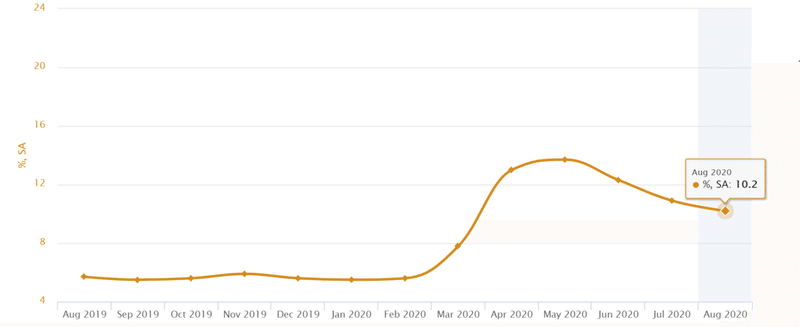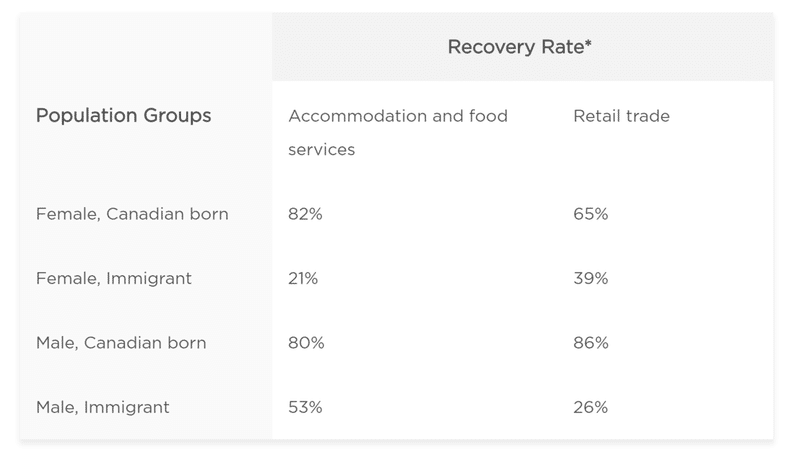
Labor market in Canada
カナダの現在のCOVID-19による影響がどの程度か労働市場について簡潔にまとめました。カナダに海外進出、移住を検討されている方もいらっしゃるかと思いますが、日本語解説を下記に記載しておりますので、必要に応じてご参照頂ければと思います。
This chart shows the unemployment rate in Canada, peaking in May 13.7% and getting lower gradually, 10.2% in August. It indicate that the economy getting better than the first two months of lockdowns. However, economists predict that it could take a time to recover the market and further advances may be harder.

(Moody's Analytics https://www.economy.com/canada/unemployment-rate)
Part-time jobs recovering faster than full-time positions in Canada which is uneven returns. Full-time jobs accounted for almost 2 million of the total shed in March and April, double part-time losses, but have been slower to recover. May, June and July saw the return of 781,000 full-time positions, versus 880,000 part-time, pointing to a labor market improvement that may not be as robust as headlines suggest. Some of the part-time gains are likely to be involuntary -- an increased proportion of Canadians are working part time because of business conditions or they couldn’t find full time employment, Statistics Canada data show.

“Now that everything is legally allowed to reopen, but with this uncertainty and cloud of the pandemic still hanging over us, how easily will we be able to make up the remaining gap?” Brendon Bernard, economist at Indeed Canada, said by phone.

Immigrant Employment in Sectors Most Affected by COVID-19
Immigrants have suffered greater job losses during the COVID-19 pandemic than Canadian-born workers. Canadian-born workers have recovered 72% of the jobs lost in March and April versus a 40% recovery for landed immigrants. Recent data from the Labor Force Survey show that among all workers, female immigrants suffered the worst job losses during the peak of the pandemic and the slowest recovery since then. This is partly due to their large representation in one of the hardest hit sectors of the economy: accommodation and food services. However, female immigrants had a higher recovery rate in retail trade compared to male immigrants since April.

(LMIC https://lmic-cimt.ca/immigrant-employment-in-sectors-most-affected-by-covid-19/)
Summary
Canada also experienced an increase in unemployment immediately after the lockdown, with a high unemployment rate of 13.7%, but job growth has since moderated and the unemployment rate has dropped to 10.2%. However, as many economists are predicting, the employment situation in Canada remains challenging. Even local Canadians are having to work part-time jobs to make full-time work difficult. Immigrants are less likely to be employed than Canadians, so the situation is likely to remain difficult for some time to come. All we can do now is hope things return to normal as soon as possible.
カナダの失業率の緩やかな低下
Moody’s Analyticsのリサーチによると、カナダの失業率は2020年5月の13.7%をピークに徐々に下降しつつあり8月には10.2%にまで下がりました。ロックダウン開始直後よりも緩やかに回復してきています。しかしエコノミストによれば、経済の回復はまだまだ時間がかかり、さらなる進展は簡単ではないと予測しています。
”法的には全て再開できるようにはなったが、しかし未だにこの不確実な状況が続く中で、状況の穴埋めをしていくことは容易ではない”とIndeed Canada のエコノミストであるBrendon Bernard氏は語っています。
労働市場の雇用形態別の状況
BloombergのUneven Returnsは、パートタイム雇用とフルタイム雇用の失業率を比較した図になります。フルタイム雇用は3~4月で200万人減少し、これはパート雇用の2倍の数値であり、回復も遅れています。ただ、パート雇用の回復が多いのは、フルタイムでの雇用の機会がなかったために、非自発的にパート雇用にならざるを得なかったとの見方もあります。
LMIC によれば、移民の雇用がカナダ人と比べててCOVID-19の影響を最も受けており、カナダ人の3~4月の失業の雇用回復が72%であるのに対して、移民の雇用は40%に留まっています。最近の労働力調査によると移民女性の雇用が最も影響を受けています。これは移民女性の多くがCOVID-19の影響を強く受けた、宿泊業や飲食業で就業していたこと起因しています。しかし一方で小売業の移民女性の雇用回復は移民男性に比べて高い状況です。
まとめ
カナダもロックダウン直後は失業が増加し失業率が13.7%と高い数値となりましたが、その後緩やかに雇用が増加し失業率は10.2%と下がりました。しかし、多くのエコノミストが予測しているように、依然としてカナダ国内の雇用状況が厳しいのは変わりません。現地のカナダ人でさえ、フルタイムでの就労が厳しくパート雇用で勤務をせざるを得ない状況です。移民の雇用はカナダ人と比べても回復率が低い為、しばらくは厳しい状況が続きそうです。今はコロナ収束を願うばかりです。
この記事が気に入ったらサポートをしてみませんか?
